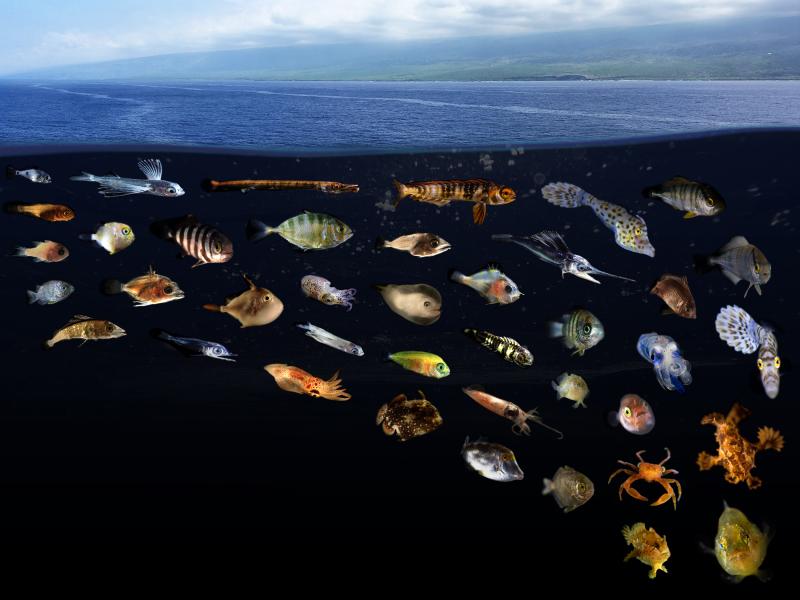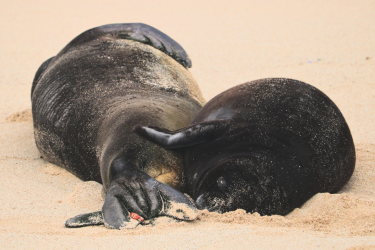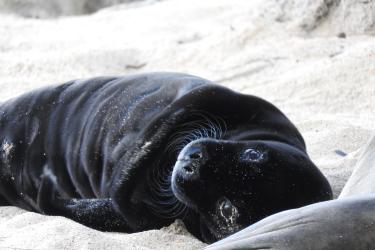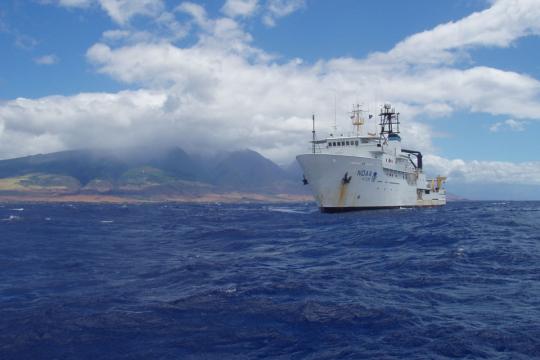To survive the open ocean, freshly hatched tiny fish larvae must find food, avoid predators, and navigate ocean currents. Their experiences during these great ocean odysseys have long been a mystery, until now. We have discovered that a surprisingly dense and diverse array of marine animals find refuge in so-called “surface slicks” during early life. To view an immersive, interactive version of this story, check out our story map: Hidden World Just Below the Surface.
Surface slicks are home to the larvae of at least 112 marine fish species, including commercially and ecologically important fish such as mahi-mahi, jacks, and billfish. Serving as makeshift nursery habitats, surface slicks are meandering lines of smooth surface water that collect plankton and shelter-providing debris. They are formed from the convergence of ocean currents, tides, and variations in the seafloor.
"These 'bioslicks' form an interconnected superhighway of rich nursery habitat that accumulate and attract thousands of young fish, along with dense concentrations of food and shelter,” says Dr. Jonathan Whitney, a research marine ecologist for NOAA and lead author of the study, published today in Scientific Reports. “The fact that surface slicks host such a large proportion of larvae, along with the resources they need to survive, tells us they are critical for the replenishment of adult fish populations.”
That larvae hosted in slick nurseries grow up and radiate out into neighboring ecosystems. There, they join adult fish populations from shallow coral reefs to the open ocean to the bottom of the deep sea.
What's more, many forage (prey) fish, like flying fish, spend their larval and juvenile life stages in surface slicks. “These biological hotspots provide more food at the base of the food chain that amplifies energy up to top predators," says study co-author Dr. Jamison Gove, a research oceanographer for NOAA. "This ultimately enhances fisheries and ecosystem productivity."
A Densely Populated Superhighway
Surface slicks are common in coastal areas around the world, including Hawai‘i. On the leeward coast of Hawaiʻi Island, slicks are a dominant and dynamic surface feature across the coastline.
The people of Hawai‘i have long recognized slicks as an important part of the seascape. The traditional Hawaiian mele (song), Kona Kai `Ōpua, references the “Ke kai ma`oki`oki,” or "the streaked sea,” in the peaceful seas of Kona. Despite these historical observations, scientists have only recently begun to understand the biological and ecological importance of surface slicks.
To unravel the slicks' secrets, NOAA’s Pacific Islands Fisheries Science Center worked with an international team of scientists. The research team conducted more than 130 plankton net tows inside the surface slicks and surrounding waters along the West Hawai‘i coastline. In these areas, they searched for larvae and other plankton that live close to the surface. They then combined those in-water surveys with satellite images of the slick footprints—a new technique for identifying these ocean features.
Though the slicks only covered around 8 percent of the ocean surface in the 380-square-mile (1,000-square-kilometer) study area, they had a disproportionately dense composition:
- An astounding 39 percent of the surface-dwelling larval fish
- More than 25 percent of its zooplankton, which the larval fish eat
- A majority (75 percent) of its floating organic debris (like feathers and leaves)
Larval fish densities in surface slicks off West Hawaiʻi were, on average, 7.2 times greater than densities in the surrounding waters.
"I love that we can bring our best field and laboratory science together with the latest in satellite mapping to generate new understanding about a phenomenon that most people confuse for boat wakes or pollution offshore,” noted co-author Dr. Greg Asnerof Arizona State University’s Center for Global Discovery and Conservation Science. “Bioslicks are actually biodiversity hotspots and nurseries for reefs and deep-water ecosystems alike."
A Popular Marine Nursery
The remarkable diversity of fish found in slick nurseries represents nearly 10 percent of all fish species recorded in Hawaiʻi. “We were shocked to find larvae of so many species, and even entire families of fish, that were only found in surface slicks," Dr. Whitney says. "This suggests they are dependent on these habitats.”
Importantly, many of these larvae didn't just happen upon the surface slicks. Eggs and little hatchlings passively accumulate in slicks—just as debris does. The study suggests that bigger larvae (those nearly half an inch, or longer than 1 centimeter) are actively targeting slicks to capitalize on concentrated prey and shelter from predators. “This reinforces the notion that, even at these small sizes, larval fish are active, competent swimmers, wayfinding and choosing where they want to be,” Dr. Whitney says.
Narrow Slicks Have a Broad Reach
“Slicks are like moving highways of plankton, bridging the pelagic and coral reef ecosystems,” Dr. Whitney says. “This movement helps retain developing reef fish larvae nearshore and even deliver bigger, ready-to-settle larvae back to coral reefs.”
Slicks also create foraging hotspots for larval fish predators. “Baby fish that grow up feeding in these biological hotspots can become bigger, faster, and better swimmers than fish growing up in surrounding waters,” explains Dr. Gove.
While slicks may seem like havens for many tiny marine animals, there's also a hidden hazard that accumulates in surface slicks: plastic debris. “Until we stop plastics from entering the ocean," Dr. Whitney says, "the accumulation of hazardous plastic debris in these nursery habitats remains a serious threat to the biodiversity hosted here.”
Until now, the ecological impact of slicks has not been extensively studied in tropical regions like Hawai‘i. The new research shows these conspicuous phenomena hold more ecological value than meets the eye.
"Our work illustrates how these oceanic features (and animals’ behavioral attraction to them) impact the entire surface community, with implications for the replenishment of adults that are important to humans for fisheries, recreation, and other ecosystem services," says Dr. Margaret McManus, co-author, Professor and Chair of the Department of Oceanography at the University of Hawaiʻi at Mānoa. “These findings will have a broad impact, changing the way we think about oceanic features as pelagic nurseries for ocean fishes and invertebrates.”







